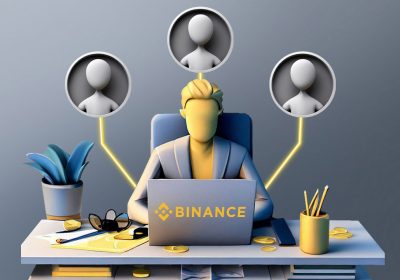An algorithmic trading strategy is a sophisticated approach to financial markets that leverages computer algorithms to execute trades. It involves using historical data and statistical models to develop trading strategies, which are then tested through backtesting. This simulation enables traders to evaluate the performance of their strategy against past market conditions.
In this article from Finestel’s Academy, we will explore a range of algorithmic trading strategies, examining how traders can study and implement them strategically in response to market opportunities. As traders gain familiarity with each strategy and its unique characteristics, they can evaluate and determine the most suitable approach for their specific trading market.
What Is Algorithmic Trading?
Algorithmic trading is a method of executing trades and orders using predefined strategies and models. There are various types and approaches to algorithmic trading, some of which involve human intervention, while others are fully automated. Certain types of algorithmic trading employ predefined strategies and mathematical models to identify the optimal timing and price for order submission. These models also dictate when to close the trade. Some algorithms focus on specific aspects, such as identifying entry and exit points or acting on data provided by a trader.
In fully automated models, market data is fed into the algorithm. Based on predefined rules, the algorithm triggers the entry point by submitting an order. Subsequently, the algorithm identifies exit or modification points in line with the predefined strategies.

It’s important to note that the evolution of machine learning and AI has dramatically enriched the scope of algorithmic trading. These advanced technologies allow the algorithm to learn from past trades and progressively refine its strategies.
This adaptability could lead to more effective trading strategies that outperform static ones, especially in changing market conditions. However, these sophisticated algorithms must be monitored closely to ensure they stay within their intended risk profile.
How Algorithmic Trading Works
Algorithmic trading has emerged as a method that uses software programs to execute trades automatically. It’s quite a mutation from traditional trading, where humans would do all the work. Over the last decade, algorithmic trading has changed the world by offering a quick, accurate, and consistent way to carry out trades. Plus, it saves traders from psychological pitfalls like emotional decisions, greed, and fear.
When a trader needs to apply complex trading strategies that might be tough or impossible for a human to perform, they use algorithmic trading. Additionally, It grants them speed, accuracy, a clear head (since emotions are left out of the equation), and the ability to apply the algorithm to their trading process.
For example, you want to create a $100 buy position for a cryptocurrency when its 50-day moving average index exceeds its 200-day moving average. You would then sell and exit the market when the 50-day moving average falls below the 200-day moving average. And there you have it. That’s it.
Strategies for Algorithmic Trading
Any algorithmic trading strategy needs to be studied and then implemented for opportunities in a market. Whenever you get familiar with any strategy and its instructions, you can identify which may suit the market you are trading at. To do so, here are common strategies for algorithmic trading:
Trend-Following Strategies
Trading strategies often closely monitor trends in various indicators. The beauty of these strategies lies in their simplicity, as they do not rely on any predictions. Focusing on trends in moving averages or other technical indicators is a classic example of a trend-following strategy. One popular such strategy involves tracking the 50-day to 200-day moving average.
Conditions of Arbitrage
Sometimes, opportunities evolve that traders can buy an asset in a market and sell it in another market. This strategy is time-sensitive and requires simultaneous executions by algorithmic trading software. This strategy can be a simple price prediction because it happens in short intervals.
Statistical Arbitrage
This strategy relies on quantitative models and the price relationship between two or more financial instruments. Its goal is to spot inefficiencies or mispricings to earn returns that have been adjusted for risk.
The shortfall in Implementation
The shortfall in implementation strategy seeks to reduce the execution cost of an order by trading in real-time markets. This way, it saves on the order cost and benefits from the opportunity cost of delayed execution. If the stock price moves favorably, the strategy will increase the targeted participation rate, and if the stock price moves negatively, it will decrease.
Strategies Based on Momentum
These strategies are designed to exploit market volatility. Algorithms are created to identify the start of a market trend (either up or down) for a particular security and then carry out trades based on that momentum.
Mean Reversion (Trading Range)
It is based on the concept that any price at its peak or bottom will move toward its average value. In this strategy, traders should capture a price range and implement the algorithm to place the trades automatically when the price breaks in or out of its determined range.
Rebalancing Index Funds
Index funds have certain times when they must rearrange their holdings to match their corresponding benchmark indices. This act of rebalancing can create movements in prices that are quite predictable. Algorithmic traders can leverage these movements, using their strategies to earn profits. In other words, index fund rebalancing is an excellent window of opportunity for those engaged in algorithmic trading.

Mathematical Models
Certain mathematical models have been proven to work well for trading. For instance, the delta-neutral trading strategy lets you trade on various options and the underlying security.
Time Weighted Average Price (TWAP)
The time-weighted average price strategy takes a big order and breaks it into smaller pieces that are determined dynamically. These smaller pieces are released to the market in spaced time intervals between a start and end time. Traders use this strategy to execute the order close to the average price between the start and end times to minimize the impact on the market.
Volume-Weighted Average Price (VWAP)
The volume-weighted average price strategy is similar to TWAP but slightly different in that the smaller pieces are released to the market using the stock-specific historical volume profiles. The goal is to execute the order close to the volume-weighted average price (VWAP).
Percentage of Volume (POV)
This algorithm sends partial orders until the trade order is filled. It does this based on the defined participation ratio and the volume traded in the markets. Traders try to define a percentage of market volume, and then this strategy sends orders at the defined volume. This percentage increases or decreases when the stock price reaches the levels defined by the trader.
Scalping
In a sentence, It is a strategy in algorithmic trading where you make many trades quickly to gain profits from small changes in market prices.
How to create an algorithmic trading strategy
Despite having a sufficient understanding of markets, trading experience, and compliance with principles, you need to be familiar with algorithmic trading strategies. Here is a step-by-step flow for creating one:
- Determine a goal: At the first step, you would better determine what you need to acquire. Based on your trading principles and lifestyle, you may specify shortened or extended time on trading, high income with high capital or consistent profit with enough capital, and so on.
- Conduct Research and choose the path: Before using such technologies, it is important to research to choose the proper market. Suppose you choose to trade in the cryptocurrency market. In that case, you need to understand the factors that affect the prices, choose the strategy, and consider fundamental events affecting the market. Here you can have a visualized strategy to use in further steps.
- Choose trading tools: You can find a data provider or trading platform for your trading operations. Based on your goals, research, and budget, choose a platform that provides an automated trading feature to program your strategy upon it.
- Create your trading algorithm: This step is extremely important. You may choose any of the strategies mentioned above or anything else to capture trading opportunities, place orders, and manage your risk. In addition, defining the time frame that comes along with your strategy as the most important factor complicates creating an algorithmic trading strategy.
- Backtesting via Historical Data: When your strategy is developed on a platform based on your rules, you must use an unreal budget until the trading bot is tested. In this step, you can analyze the performance of your algorithm based on several variables defined for measuring that strategy.
- Execution and Monitoring: After any assessment and measures to ensure your strategy moves toward your goal, you are ready to connect it to an environment with real-world money. Once it starts performing your rules in the live market, keep an eye on it to ensure it aligns with the previous step’s results. Suppose you run it in a market such as a cryptocurrency market, which affects a lot by fundamental events. In that case, you need to have permanent monitoring and change any rule according to the conditions of the market.
What Is the Most Profitable Algorithmic Trading Strategy?
Identifying the most profitable algorithmic trading strategy is complex as it depends on various factors such as market conditions, risk tolerance, and individual preferences. Some commonly recognized profitable strategies include trend following, mean reversion, and arbitrage.
Still, it’s important to note that success can vary based on the specific implementation and adaptation of these strategies to prevailing market conditions. Conducting thorough research and rigorous testing is essential to determine the strategy that best aligns with your trading goals and objectives.
In addition to considering various factors for a successful algorithmic trading strategy, such as market conditions and strategy implementation, it is crucial to emphasize the importance of risk and capital management.
Effective risk management helps protect against unexpected market fluctuations and potential losses, while sound capital management ensures optimal allocation of resources to maximize overall returns. Integrating robust risk and capital management practices within algorithmic trading strategies is essential for long-term success and mitigating potential risks.
Advantages and Disadvantages of Algorithmic Trading
Algorithmic trading offers numerous advantages, including increased speed and efficiency and reduced emotional bias. At the same time, it poses challenges, such as technical risks, market risks, and the potential for over-optimization. Here are the advantages and disadvantages of implementing an algorithmic trading strategy:
Advantages:
- Speed and Efficiency: Computers can process complex calculations faster than humans and execute trades optimally. They can monitor a wide range of markets or securities simultaneously.
- Reduced Risk of Manual Errors: By automating the trading process, the likelihood of errors that could occur in manual trading is significantly reduced.
- Backtesting: in an algorithmic trading system, we can simulate the market by feeding historical data to the algorithm and evaluating the performance and details of the algorithm.
- Elimination of Emotional and Psychological Factors: Trading decisions are made based on pre-set rules and patterns, eliminating the impact of emotional decisions and psychological biases.
Disadvantages:
- System Failure: Like any computerized system, algorithmic trading is susceptible to failures such as network connectivity issues, computer crashes, power losses, and even programming errors in the algorithm itself.
- Lack of Control: Traders may need more control over their trades, mainly if the algorithm performs differently than expected or responds to sudden market changes.
- Over-Optimization: An algorithm could be over-optimized to specific historic market conditions and may not perform well when market conditions change.
- Difficulty in Monitoring: Algorithms are often complex and challenging to understand. Monitoring operations and intervening if something goes wrong can be complicated.
The Key Components of a Successful Algorithmic Trading Strategy
The foundations of a successful algorithmic trading strategy are built upon multiple interconnected components. These include market analysis, mathematical or AI models, risk and capital management, backtesting, performance evaluation, implementation, maintenance, and regulatory compliance. Each component is vital in formulating and executing an effective trading strategy.
The market analysis serves as the initial roadmap for strategy formulation. By studying market trends, historical data, and sector-specific information, traders can gain valuable insights to inform their approach. A mathematical or AI-based model is then used to predict market movements and make informed trading decisions based on predetermined rules.
Risk and capital management are crucial for mitigating potential losses and ensuring the effective use of capital. Risk management involves setting maximum loss thresholds, determining risk-reward ratios, and adjusting leverage based on market volatility. Capital management strategies focus on determining appropriate risk allocation and maintaining balance in the trading account.
Backtesting the trading strategy against historical data helps refine and validate its potential viability. Regular performance evaluation using metrics like net profit, drawdown, and the Sharpe ratio ensures the strategy remains relevant and effective. Implementation involves coding the strategy into a computer program for automated execution, followed by continuous maintenance, monitoring, and fine-tuning based on changing market conditions and performance metrics.
Regulatory compliance is essential to ensure the trading strategy adheres to applicable regulations, safeguarding both the strategy and the trader.
In summary, the success of an algorithmic trading strategy depends on the cooperative interplay of various components. Combining market analysis, mathematical or AI models, risk and capital management, backtesting, performance evaluation, implementation, maintenance, and regulatory compliance increases the likelihood of an effective trading strategy.
The Importance of Risk Management in Algorithmic Trading
Risk management and performance evaluation hold a significant role in algorithmic trading, underlining the importance of robust supervision to ensure the success and sustainability of trading strategies.

Risk management in algorithmic trading is a safeguard against the inherent unpredictability of financial markets. Despite the most carefully crafted models and strategies, market volatility often results in unexpected outcomes. Therefore, risk management protocols become essential, such as setting maximum loss thresholds and adjusting leverage based on market volatility. They protect the trader’s capital, ensuring sustainability in trading operations even when facing adverse market conditions.
Performance evaluation, on the other hand, is the measure of a strategy’s effectiveness. Regularly assessing the trading strategy’s performance against established benchmarks and key performance indicators, such as net profit, drawdown, and the Sharpe ratio, provides insight into the strategy’s ongoing relevance and effectiveness. It aids in detecting any performance degradation over time, thus highlighting areas that may need adjustment or improvement.
Supervision in algorithmic trading encompasses both risk management and performance evaluation. It involves continuous monitoring and fine-tuning of the trading algorithms, ensuring they operate as intended and maintain the trader’s risk profile. Regular supervision helps identify any anomalies early, reducing the potential for significant trading errors or malfunctions، safeguarding the strategy and the trader.
The importance of risk management, performance evaluation, and supervision in algorithmic trading cannot be overstated.
Conclusion
In conclusion, various types exist for algorithmic trading; some operate fully automatically, overseeing the entire process from identifying entry and exit points to managing risk and capital. On the other hand, others serve as tools to aid traders in navigating the market.
A successful algorithmic trading strategy should include a decision-making model. This model analyzes the market, devises strategies, and implements robust risk and capital management protocols. Before deploying such a service, it’s essential to conduct backtesting on historical data. After that, continuous algorithm monitoring is required for fine-tuning and identifying optimal conditions for launching and operating the algorithms.
Nowadays, the advancement of artificial intelligence (AI) presents the potential for AI-based algorithmic trading services. These services learn from their trades, constantly optimizing their algorithms.
Regardless of the model or implementation, all algorithmic trading requires regular monitoring and maintenance. Evaluating the outcomes of trades and algorithms allows for their enhancement, ensuring they perform better over time. In the rapidly evolving world of trading, a system’s ability to learn and adapt is invaluable.
FAQ
How do I choose the right trading platform for algorithmic trading?
You should consider factors such as compatibility, data feeds, order execution, risk management, scalability, and community support when selecting an algorithmic trading platform.
What is the future of algorithmic trading and the role of AI in trading strategies?
AI might revolutionize trading strategies through advanced algorithms, improved prediction accuracy, and uncovering hidden market data patterns.
How successful is algorithmic trading?
It has been adopted by financial institutions and individual traders and capitalizing on market inefficiencies for improved trading outcomes.
What is the most profitable automated trading strategy?
It can vary depending on market conditions and individual preferences. Strategies like trend following and mean reversion have succeeded in different market scenarios.






Leave a Reply